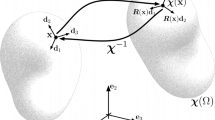Abstract
We consider a linear reduced Cosserat medium: a linear elastic continuum, whose point bodies possess kinematically independent translational and rotational degrees of freedom, but the strain energy does not depend on the gradient of rotation of particles. In such a medium the force stress tensor is asymmetric, but the couple stress tensor is zero. This model can be applied for description of soils and granular media. Since for the time being the experimental technique for measurement of rotational deformations is not well developed, we investigate how the presence of rotational degrees of freedom affects the dynamics of translational displacements. We consider the case of the spherical tensor of inertia and isotropy with respect to the rotational degrees of freedom. Integration of the equation of balance of torques lets us in several cases to put in correspondence a linear reduced Cosserat continuum with the spherical tensor of inertia with a classical (non-polar elastic linear) medium with memory with the same equation for the balance of forces, written in terms of translational displacements. This is possible for the isotropic case and also if the anisotropy is present only in the tensor of elastic constants corresponding to the classical strain tensor. If the material is isotropic with respect to rotational deformations but the (anisotropic) coupling between rotational and classical translational strains is present, then the corresponding classical medium does not exist. If we ignore the rotational degrees of freedom when this coupling is present, this will lead us to the conclusion that the principle of material objectivity is violated.
Similar content being viewed by others
References
E. Cosserat and F. Cosserat, Théorie des corps déformables (A. Hermann et fils, Paris, 1909).
V. A. Pal’mov, “Fundamental Equations of the Theory of Asymmetric Elasticity,” Prikl. Mat. Mekh. 28(3), 401–408 (1964) [J. Appl.Math. Mech. (Engl. Transl.) 28 (3), 496–505 (1964)].
E. L. Aero and E. V. Kuvshinskii, “Continuous Theory of Asymmetric Elasticity. Equilibrium of an Isotropic Body,” Fiz. Tverd. Tela 6(9), 2689–2699 (1964) [Sov. Phys. Solid State (Engl. Transl.) 6, 2141–2148 (1965)].
C. B. Kafadar and A. C. Eringen, “Micropolar Media — I. The classical theory,” Int. J. Engng Sci. 9(3), 271–305 (1971).
P. A. Zhilin, Rational Continuum Mechanics (Izd-vo Politekhn. un-ta, St. Petersburg, 2012) [in Russian].
W. Nowacki. Theory of elasticity (PWN, Warsaw, 1970; Mir, Moscow, 1975).
A. C. Eringen. Microcontinuum Field Theories. Foundations and Solids, Vol. 1. (Springer, New York, 1999).
V. I. Erofeyev. Wave Processes in Solids with Microstructure (Izd-vo MGU, Moscow, 1999; World Scientific Publ., 2003).
G. Maugin, Continuum Mechanics of Electromagnetic Solids (North-Holland, Amsterdam, 1988; Moscow, Mir, 1991).
E. Grekova and P. Zhilin. “Basic Equations of Kelvin’s Medium and Analogy with Ferromagnets,” J. Elasticity 64(1), 29–70 (2001).
I. Vardoulakis, “Shear-Banding and Liquefaction in Granular Materials on the Basis of a Cosserat Continuum Theory,” Arch. Appl. Mech. 59(2), 106–113 (1989).
A. S. J. Suiker, A. V. Metrikine, and R. De Borst, “Comparison of Wave Propagation Characteristics of the Cosserat Continuum Model and Corresponding Discrete Lattice Models,” Int. J. Solids Struct. 38(9), 1563–1583 (2001).
“Special Issue on the Rotational Seismology,” Bull. Seismol. Soc. Am. 99(2B) (2009).
L. M. Schwartz, D. L. Johnson, and S. Feng, “Vibrational Modes in Granular Materials,” Phys. Rev. Lett. 52(10), 831–834 (1984).
E. F. Grekova, M. A. Kulesh, and G. C. Herman, “Waves in Linear Elastic Media with Microrotations. Part 2: Isotropic Reduced Cosserat Model,” Bull. Seismol. Soc. Am. 99(2B), 1423–1428 (2009).
M.A. Kulesh, E. F. Grekova, and I.N. Shardakov, “The Problem of Surface Wave Propagation in a Reduced Cosserat Medium,” Akust. Zh. 55(2), 216–225 (2009) [Acoust. Phys. (Engl. Transl.) 55 (2), 218–226 (2009)].
E. F. Grekova, Nonlinear reduced Cosserat continuum “Nonlinear Isotropic Elastic Reduced Cosserat Continuum as a Possible Model for Geomedium and Geomaterials. Spherical Prestressed State in the Semilinear Material,” J. Seismol. 16(4), 695–707 (2012).
Author information
Authors and Affiliations
Corresponding author
Additional information
Original Russian Text © E.F. Grekova, 2012, published in Izvestiya Akademii Nauk. Mekhanika Tverdogo Tela, 2012, No. 5, pp. 58–64.
About this article
Cite this article
Grekova, E.F. Linear reduced cosserat medium with spherical tensor of inertia, where rotations are not observed in experiment. Mech. Solids 47, 538–543 (2012). https://doi.org/10.3103/S002565441205007X
Received:
Published:
Issue Date:
DOI: https://doi.org/10.3103/S002565441205007X




